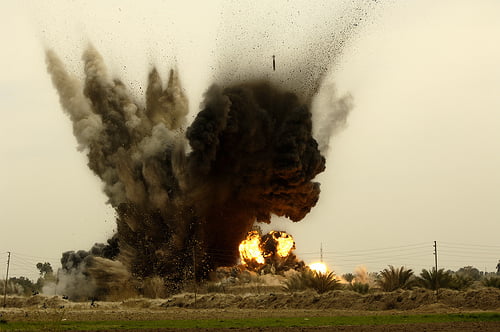Last week, King’s College researchers in London published a study looking into the gory details of how people were killed during the Iraq War. Based on this research, they offer some insight about how civilian casualties might be reduced in future combat.
While unknown combatants (i.e. groups and individuals acting on their own) were the biggest killers of civilians, U.S.-led coalition forces also killed a high proportion of civilians, particularly through aerial bombardment. In “Violent Deaths of Iraqi Civilians, 2003-2008: Analysis by Perpetrator, Weapon, Time, and Location,” (Public Library of Science Medicine Journal) Hicks, et al, recommend that the “use of transparent, verifiable systems for tracking and measuring civilian and combatant casualties from all military actions could identify civilian-protective tactics (e.g., careful targeting, or less frequent use of weapons) and would allow rapid identification, correction, and deterrence of civilian harmful tactics.”
As a former U.S. Marine who later served as a civilian aid worker in several war zones and as a peacebuilding program director in Iraq, I believe it is too soon to stop looking back at what could have saved more lives during the Iraq War. This study and more like it should be welcomed and discussed on every podium. After all, we’re talking about why innocent people are being killed, and how that can be prevented.
Combat does not only unleash logical and strategic moves between armies or even between armies and militias, but also unleashes a large collection of groups and individuals working to get money, eliminate competition, take on people they are bigoted against, or who just have the murder gene. Governments, donors, civil society groups, and traditional networks seeking to prevent violence may be better equipped to do so if instead of focusing around bi-lateral political talks they address a plethora of different kinds of motivations which would best be tracked and understood by public mechanisms like that suggested by the study which break down apparent motivations down to the smallest subset.
In one notorious case in Iraq, for example, a militia was not only killing men of a second ethnic group to “cleanse” their neighborhood but was also keeping a hospital for use only by their group. When members of the other group arrived wounded they were either not treated or were murdered on delivery. When peacebuilding groups working on reconciliation got working in the neighborhood, they had no idea that the hospital played a role in the killing, and should have played a role in how killing could have been reduced. It was a common resource two groups could rely on together, which instead remained a resource controlled by one group.
Perhaps an even more important finding which must be discussed openly and truthfully, is that of the destructive power of aerial bombardment. While governments including the U.S. talk during press conferences about precision weapons like Tomahawk missiles, they continue to use non-precision weapons in combat. Doing so directs public scrutiny away from the military’s actions in the field. The study reminds us that even the U.S. is a long way from precision warfare.
Each time a war ends, many people begin to feel comforted that “it” is over, that humanity’s killing seasons are over, that we’ve grown beyond that. But we as a society rarely look back, track, debate and discuss these dilemmas openly and truthfully, and that’s why killings of civilians are still committed not only by thugs but also by educated, modern societies like ours.
Photo: U.S. Army.
